Business and Business Environment Analysis Report for UK Organizations
VerifiedAdded on 2023/01/19
|21
|6427
|87
Report
AI Summary
This report provides a comprehensive analysis of the UK business environment, examining different types of organizations including public, private, and voluntary sectors, with examples like H&M, Cancer Research UK, and Network Rail. It explores their purposes, legal structures, size, and scope. The report delves into organizational functions and their interrelationships, followed by an assessment of the positive and negative impacts of the macro environment. Furthermore, it includes an internal and external analysis of these organizations, employing SWOT analysis to identify strengths, weaknesses, opportunities, and threats, and explaining how these factors interact with external influences. The report offers insights into how businesses operate within the UK context, considering various environmental factors and strategic considerations.
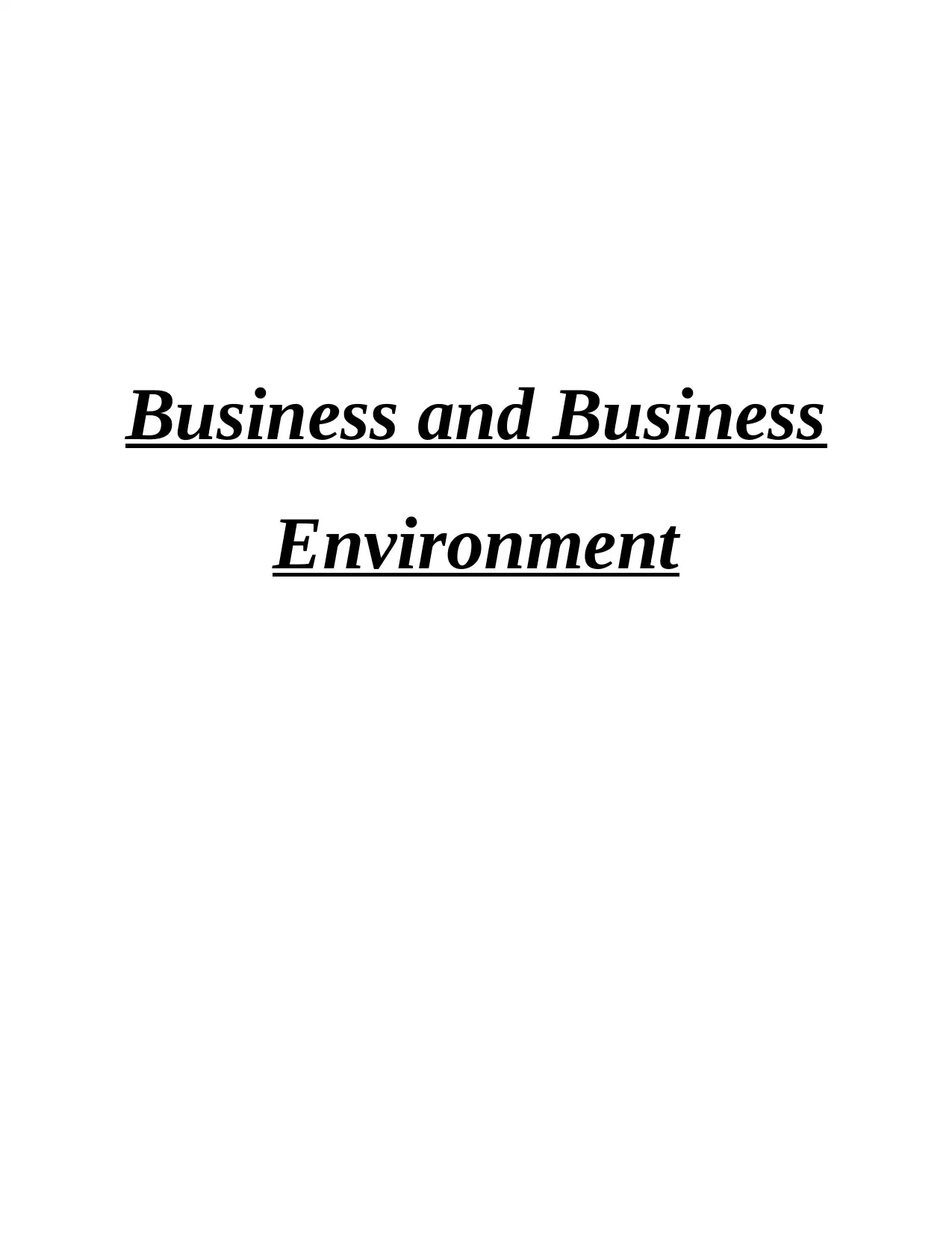
Business and Business
Environment
Environment
Paraphrase This Document
Need a fresh take? Get an instant paraphrase of this document with our AI Paraphraser
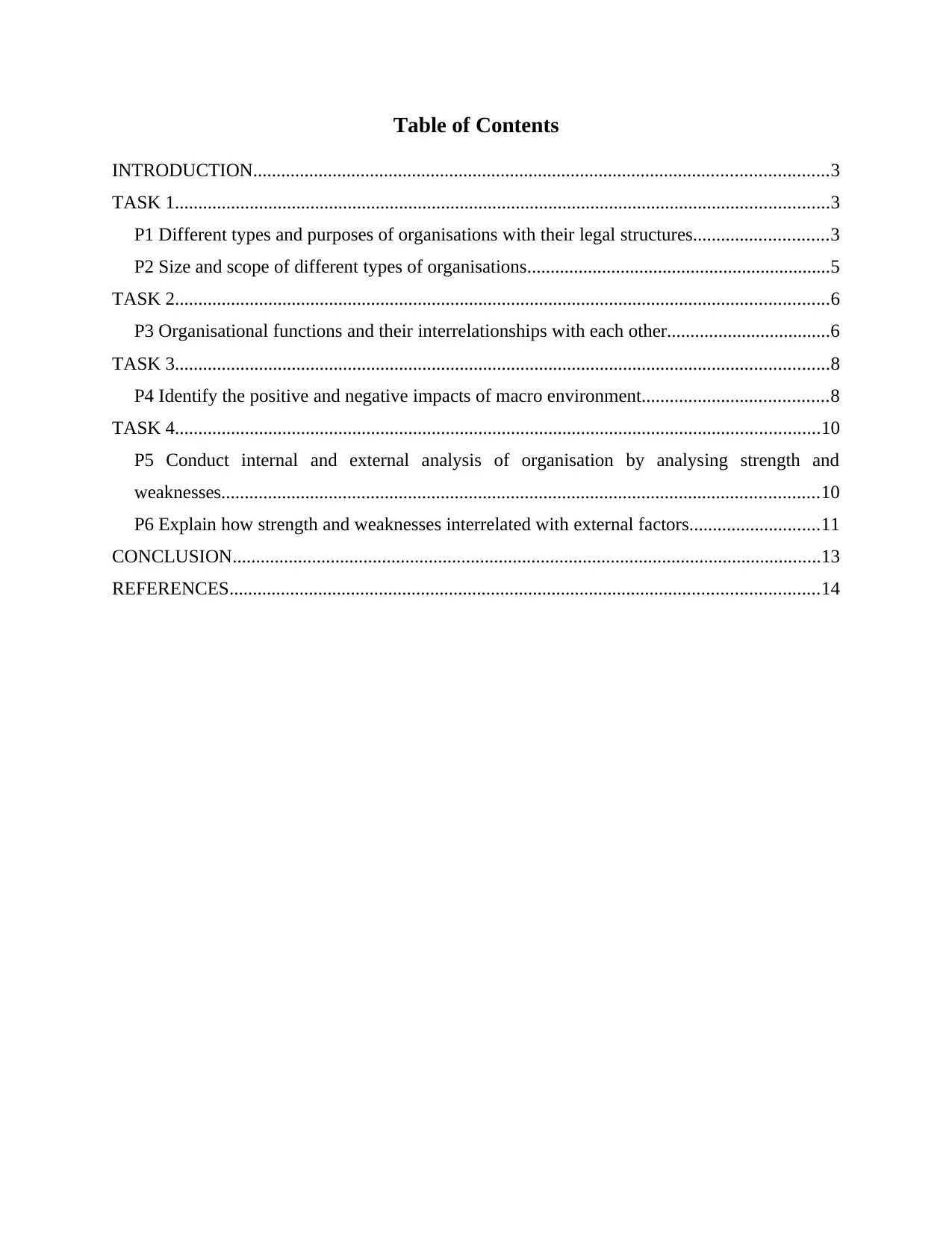
Table of Contents
INTRODUCTION...........................................................................................................................3
TASK 1............................................................................................................................................3
P1 Different types and purposes of organisations with their legal structures.............................3
P2 Size and scope of different types of organisations.................................................................5
TASK 2............................................................................................................................................6
P3 Organisational functions and their interrelationships with each other...................................6
TASK 3............................................................................................................................................8
P4 Identify the positive and negative impacts of macro environment........................................8
TASK 4..........................................................................................................................................10
P5 Conduct internal and external analysis of organisation by analysing strength and
weaknesses................................................................................................................................10
P6 Explain how strength and weaknesses interrelated with external factors............................11
CONCLUSION..............................................................................................................................13
REFERENCES..............................................................................................................................14
INTRODUCTION...........................................................................................................................3
TASK 1............................................................................................................................................3
P1 Different types and purposes of organisations with their legal structures.............................3
P2 Size and scope of different types of organisations.................................................................5
TASK 2............................................................................................................................................6
P3 Organisational functions and their interrelationships with each other...................................6
TASK 3............................................................................................................................................8
P4 Identify the positive and negative impacts of macro environment........................................8
TASK 4..........................................................................................................................................10
P5 Conduct internal and external analysis of organisation by analysing strength and
weaknesses................................................................................................................................10
P6 Explain how strength and weaknesses interrelated with external factors............................11
CONCLUSION..............................................................................................................................13
REFERENCES..............................................................................................................................14
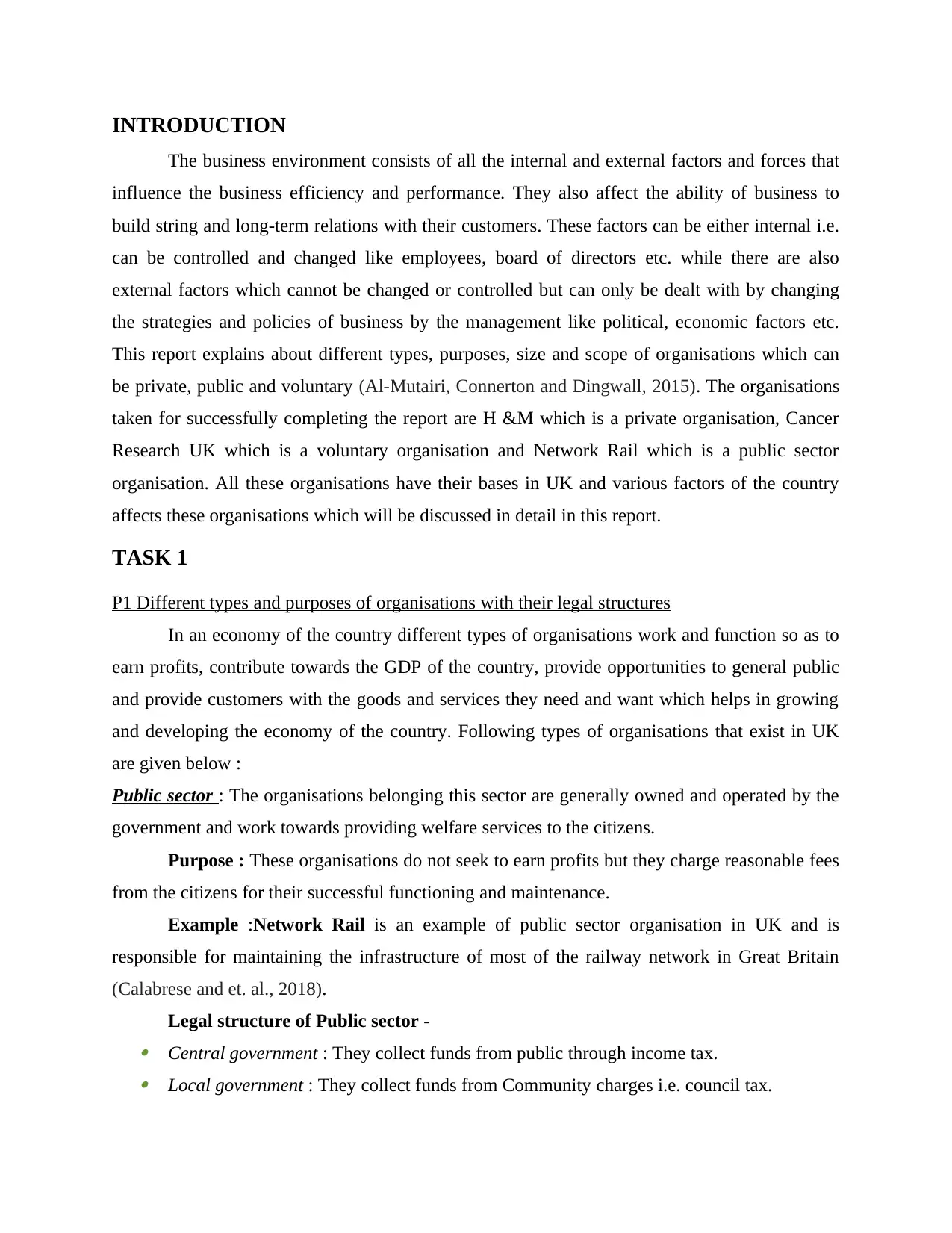
INTRODUCTION
The business environment consists of all the internal and external factors and forces that
influence the business efficiency and performance. They also affect the ability of business to
build string and long-term relations with their customers. These factors can be either internal i.e.
can be controlled and changed like employees, board of directors etc. while there are also
external factors which cannot be changed or controlled but can only be dealt with by changing
the strategies and policies of business by the management like political, economic factors etc.
This report explains about different types, purposes, size and scope of organisations which can
be private, public and voluntary (Al-Mutairi, Connerton and Dingwall, 2015). The organisations
taken for successfully completing the report are H &M which is a private organisation, Cancer
Research UK which is a voluntary organisation and Network Rail which is a public sector
organisation. All these organisations have their bases in UK and various factors of the country
affects these organisations which will be discussed in detail in this report.
TASK 1
P1 Different types and purposes of organisations with their legal structures
In an economy of the country different types of organisations work and function so as to
earn profits, contribute towards the GDP of the country, provide opportunities to general public
and provide customers with the goods and services they need and want which helps in growing
and developing the economy of the country. Following types of organisations that exist in UK
are given below :
Public sector : The organisations belonging this sector are generally owned and operated by the
government and work towards providing welfare services to the citizens.
Purpose : These organisations do not seek to earn profits but they charge reasonable fees
from the citizens for their successful functioning and maintenance.
Example :Network Rail is an example of public sector organisation in UK and is
responsible for maintaining the infrastructure of most of the railway network in Great Britain
(Calabrese and et. al., 2018).
Legal structure of Public sector - Central government : They collect funds from public through income tax. Local government : They collect funds from Community charges i.e. council tax.
The business environment consists of all the internal and external factors and forces that
influence the business efficiency and performance. They also affect the ability of business to
build string and long-term relations with their customers. These factors can be either internal i.e.
can be controlled and changed like employees, board of directors etc. while there are also
external factors which cannot be changed or controlled but can only be dealt with by changing
the strategies and policies of business by the management like political, economic factors etc.
This report explains about different types, purposes, size and scope of organisations which can
be private, public and voluntary (Al-Mutairi, Connerton and Dingwall, 2015). The organisations
taken for successfully completing the report are H &M which is a private organisation, Cancer
Research UK which is a voluntary organisation and Network Rail which is a public sector
organisation. All these organisations have their bases in UK and various factors of the country
affects these organisations which will be discussed in detail in this report.
TASK 1
P1 Different types and purposes of organisations with their legal structures
In an economy of the country different types of organisations work and function so as to
earn profits, contribute towards the GDP of the country, provide opportunities to general public
and provide customers with the goods and services they need and want which helps in growing
and developing the economy of the country. Following types of organisations that exist in UK
are given below :
Public sector : The organisations belonging this sector are generally owned and operated by the
government and work towards providing welfare services to the citizens.
Purpose : These organisations do not seek to earn profits but they charge reasonable fees
from the citizens for their successful functioning and maintenance.
Example :Network Rail is an example of public sector organisation in UK and is
responsible for maintaining the infrastructure of most of the railway network in Great Britain
(Calabrese and et. al., 2018).
Legal structure of Public sector - Central government : They collect funds from public through income tax. Local government : They collect funds from Community charges i.e. council tax.
⊘ This is a preview!⊘
Do you want full access?
Subscribe today to unlock all pages.

Trusted by 1+ million students worldwide
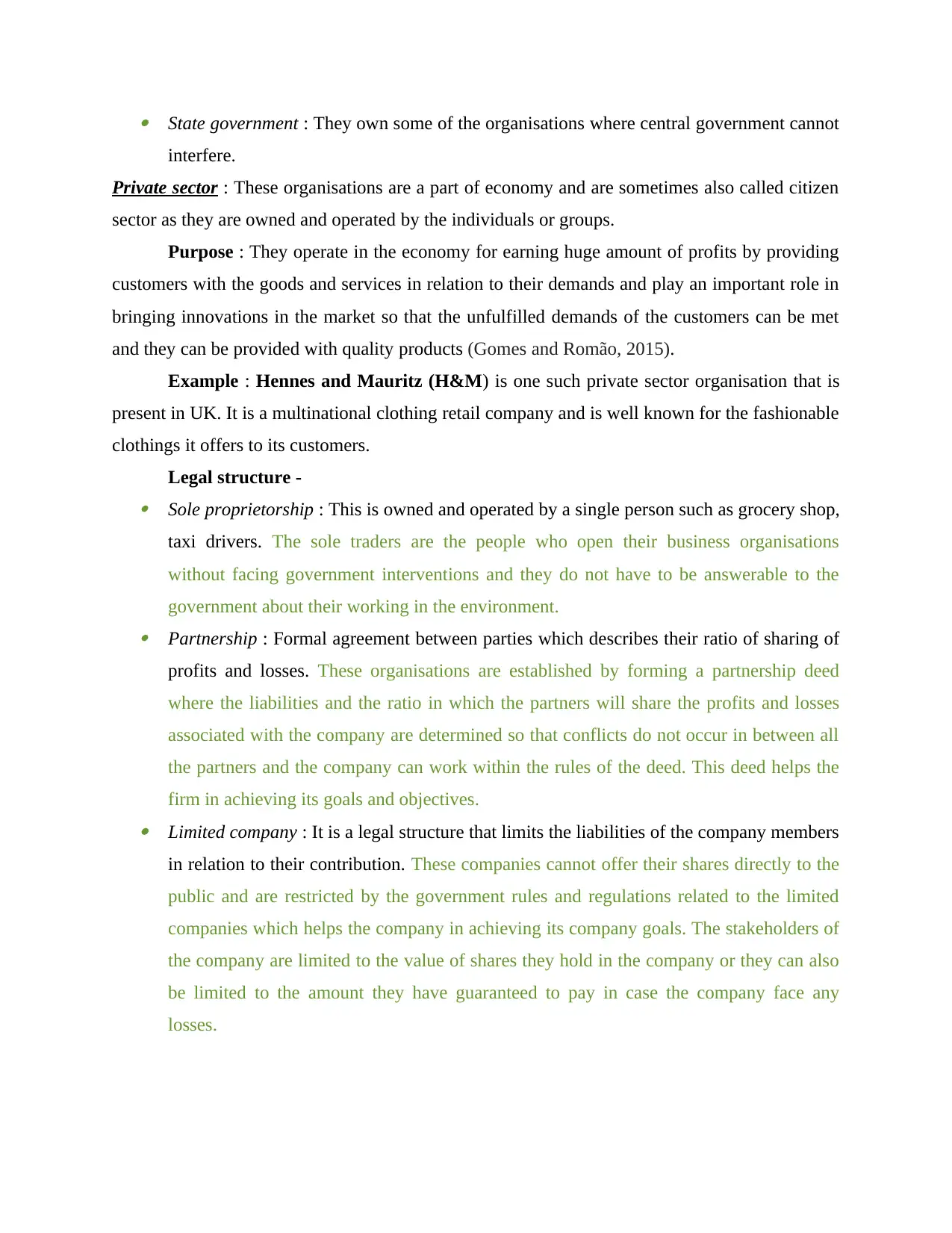
State government : They own some of the organisations where central government cannot
interfere.
Private sector : These organisations are a part of economy and are sometimes also called citizen
sector as they are owned and operated by the individuals or groups.
Purpose : They operate in the economy for earning huge amount of profits by providing
customers with the goods and services in relation to their demands and play an important role in
bringing innovations in the market so that the unfulfilled demands of the customers can be met
and they can be provided with quality products (Gomes and Romão, 2015).
Example : Hennes and Mauritz (H&M) is one such private sector organisation that is
present in UK. It is a multinational clothing retail company and is well known for the fashionable
clothings it offers to its customers.
Legal structure - Sole proprietorship : This is owned and operated by a single person such as grocery shop,
taxi drivers. The sole traders are the people who open their business organisations
without facing government interventions and they do not have to be answerable to the
government about their working in the environment. Partnership : Formal agreement between parties which describes their ratio of sharing of
profits and losses. These organisations are established by forming a partnership deed
where the liabilities and the ratio in which the partners will share the profits and losses
associated with the company are determined so that conflicts do not occur in between all
the partners and the company can work within the rules of the deed. This deed helps the
firm in achieving its goals and objectives. Limited company : It is a legal structure that limits the liabilities of the company members
in relation to their contribution. These companies cannot offer their shares directly to the
public and are restricted by the government rules and regulations related to the limited
companies which helps the company in achieving its company goals. The stakeholders of
the company are limited to the value of shares they hold in the company or they can also
be limited to the amount they have guaranteed to pay in case the company face any
losses.
interfere.
Private sector : These organisations are a part of economy and are sometimes also called citizen
sector as they are owned and operated by the individuals or groups.
Purpose : They operate in the economy for earning huge amount of profits by providing
customers with the goods and services in relation to their demands and play an important role in
bringing innovations in the market so that the unfulfilled demands of the customers can be met
and they can be provided with quality products (Gomes and Romão, 2015).
Example : Hennes and Mauritz (H&M) is one such private sector organisation that is
present in UK. It is a multinational clothing retail company and is well known for the fashionable
clothings it offers to its customers.
Legal structure - Sole proprietorship : This is owned and operated by a single person such as grocery shop,
taxi drivers. The sole traders are the people who open their business organisations
without facing government interventions and they do not have to be answerable to the
government about their working in the environment. Partnership : Formal agreement between parties which describes their ratio of sharing of
profits and losses. These organisations are established by forming a partnership deed
where the liabilities and the ratio in which the partners will share the profits and losses
associated with the company are determined so that conflicts do not occur in between all
the partners and the company can work within the rules of the deed. This deed helps the
firm in achieving its goals and objectives. Limited company : It is a legal structure that limits the liabilities of the company members
in relation to their contribution. These companies cannot offer their shares directly to the
public and are restricted by the government rules and regulations related to the limited
companies which helps the company in achieving its company goals. The stakeholders of
the company are limited to the value of shares they hold in the company or they can also
be limited to the amount they have guaranteed to pay in case the company face any
losses.
Paraphrase This Document
Need a fresh take? Get an instant paraphrase of this document with our AI Paraphraser
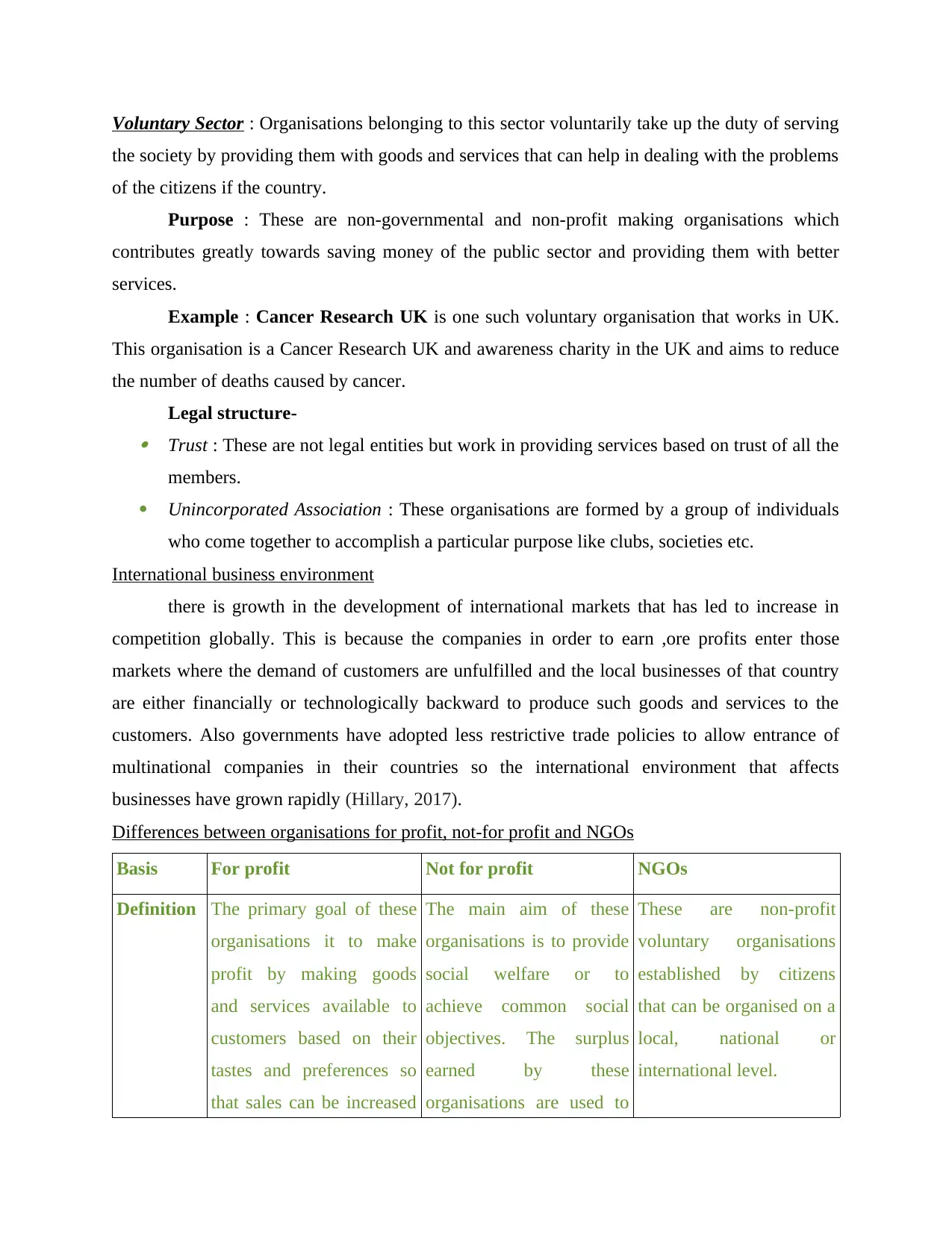
Voluntary Sector : Organisations belonging to this sector voluntarily take up the duty of serving
the society by providing them with goods and services that can help in dealing with the problems
of the citizens if the country.
Purpose : These are non-governmental and non-profit making organisations which
contributes greatly towards saving money of the public sector and providing them with better
services.
Example : Cancer Research UK is one such voluntary organisation that works in UK.
This organisation is a Cancer Research UK and awareness charity in the UK and aims to reduce
the number of deaths caused by cancer.
Legal structure- Trust : These are not legal entities but work in providing services based on trust of all the
members.
Unincorporated Association : These organisations are formed by a group of individuals
who come together to accomplish a particular purpose like clubs, societies etc.
International business environment
there is growth in the development of international markets that has led to increase in
competition globally. This is because the companies in order to earn ,ore profits enter those
markets where the demand of customers are unfulfilled and the local businesses of that country
are either financially or technologically backward to produce such goods and services to the
customers. Also governments have adopted less restrictive trade policies to allow entrance of
multinational companies in their countries so the international environment that affects
businesses have grown rapidly (Hillary, 2017).
Differences between organisations for profit, not-for profit and NGOs
Basis For profit Not for profit NGOs
Definition The primary goal of these
organisations it to make
profit by making goods
and services available to
customers based on their
tastes and preferences so
that sales can be increased
The main aim of these
organisations is to provide
social welfare or to
achieve common social
objectives. The surplus
earned by these
organisations are used to
These are non-profit
voluntary organisations
established by citizens
that can be organised on a
local, national or
international level.
the society by providing them with goods and services that can help in dealing with the problems
of the citizens if the country.
Purpose : These are non-governmental and non-profit making organisations which
contributes greatly towards saving money of the public sector and providing them with better
services.
Example : Cancer Research UK is one such voluntary organisation that works in UK.
This organisation is a Cancer Research UK and awareness charity in the UK and aims to reduce
the number of deaths caused by cancer.
Legal structure- Trust : These are not legal entities but work in providing services based on trust of all the
members.
Unincorporated Association : These organisations are formed by a group of individuals
who come together to accomplish a particular purpose like clubs, societies etc.
International business environment
there is growth in the development of international markets that has led to increase in
competition globally. This is because the companies in order to earn ,ore profits enter those
markets where the demand of customers are unfulfilled and the local businesses of that country
are either financially or technologically backward to produce such goods and services to the
customers. Also governments have adopted less restrictive trade policies to allow entrance of
multinational companies in their countries so the international environment that affects
businesses have grown rapidly (Hillary, 2017).
Differences between organisations for profit, not-for profit and NGOs
Basis For profit Not for profit NGOs
Definition The primary goal of these
organisations it to make
profit by making goods
and services available to
customers based on their
tastes and preferences so
that sales can be increased
The main aim of these
organisations is to provide
social welfare or to
achieve common social
objectives. The surplus
earned by these
organisations are used to
These are non-profit
voluntary organisations
established by citizens
that can be organised on a
local, national or
international level.
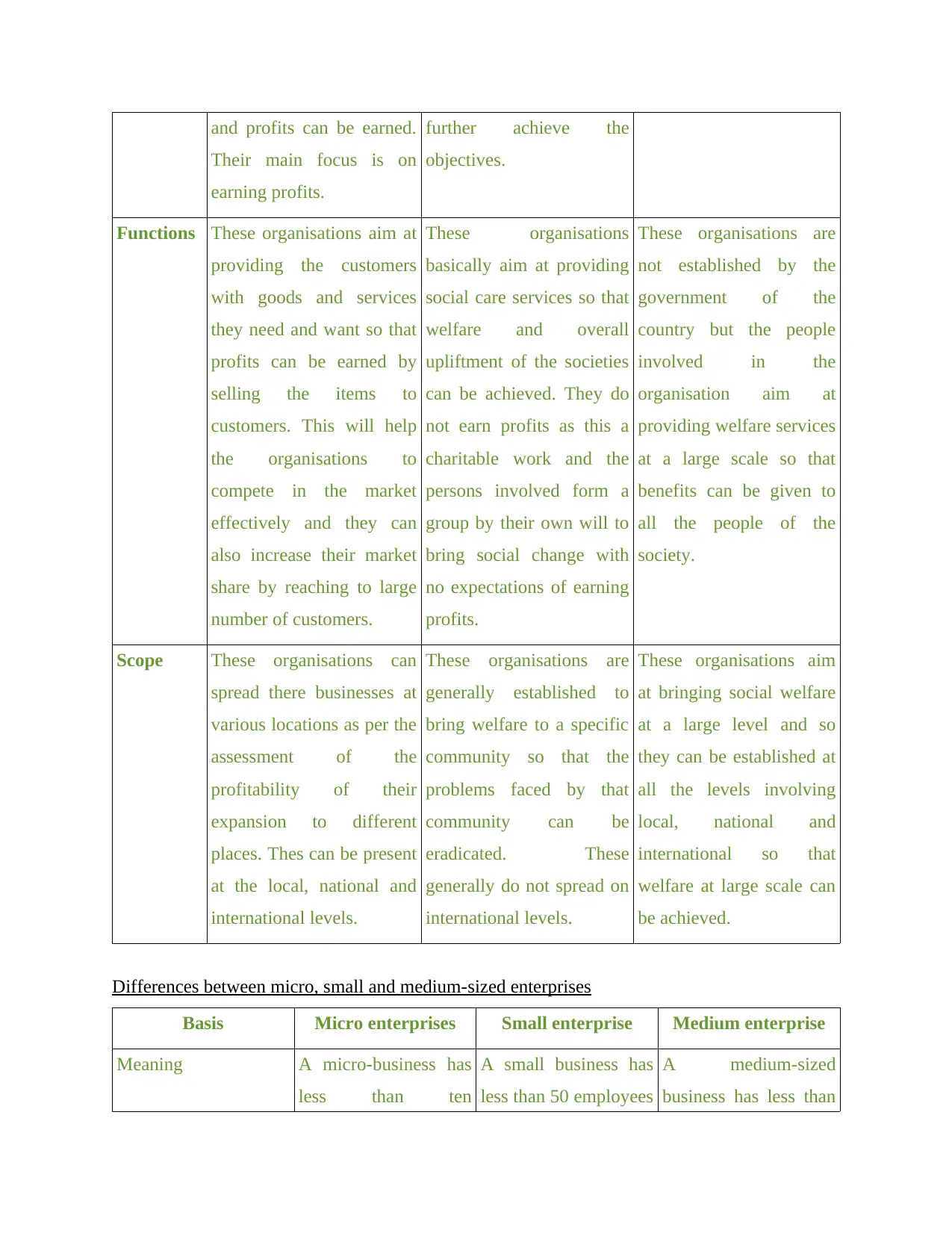
and profits can be earned.
Their main focus is on
earning profits.
further achieve the
objectives.
Functions These organisations aim at
providing the customers
with goods and services
they need and want so that
profits can be earned by
selling the items to
customers. This will help
the organisations to
compete in the market
effectively and they can
also increase their market
share by reaching to large
number of customers.
These organisations
basically aim at providing
social care services so that
welfare and overall
upliftment of the societies
can be achieved. They do
not earn profits as this a
charitable work and the
persons involved form a
group by their own will to
bring social change with
no expectations of earning
profits.
These organisations are
not established by the
government of the
country but the people
involved in the
organisation aim at
providing welfare services
at a large scale so that
benefits can be given to
all the people of the
society.
Scope These organisations can
spread there businesses at
various locations as per the
assessment of the
profitability of their
expansion to different
places. Thes can be present
at the local, national and
international levels.
These organisations are
generally established to
bring welfare to a specific
community so that the
problems faced by that
community can be
eradicated. These
generally do not spread on
international levels.
These organisations aim
at bringing social welfare
at a large level and so
they can be established at
all the levels involving
local, national and
international so that
welfare at large scale can
be achieved.
Differences between micro, small and medium-sized enterprises
Basis Micro enterprises Small enterprise Medium enterprise
Meaning A micro-business has
less than ten
A small business has
less than 50 employees
A medium-sized
business has less than
Their main focus is on
earning profits.
further achieve the
objectives.
Functions These organisations aim at
providing the customers
with goods and services
they need and want so that
profits can be earned by
selling the items to
customers. This will help
the organisations to
compete in the market
effectively and they can
also increase their market
share by reaching to large
number of customers.
These organisations
basically aim at providing
social care services so that
welfare and overall
upliftment of the societies
can be achieved. They do
not earn profits as this a
charitable work and the
persons involved form a
group by their own will to
bring social change with
no expectations of earning
profits.
These organisations are
not established by the
government of the
country but the people
involved in the
organisation aim at
providing welfare services
at a large scale so that
benefits can be given to
all the people of the
society.
Scope These organisations can
spread there businesses at
various locations as per the
assessment of the
profitability of their
expansion to different
places. Thes can be present
at the local, national and
international levels.
These organisations are
generally established to
bring welfare to a specific
community so that the
problems faced by that
community can be
eradicated. These
generally do not spread on
international levels.
These organisations aim
at bringing social welfare
at a large level and so
they can be established at
all the levels involving
local, national and
international so that
welfare at large scale can
be achieved.
Differences between micro, small and medium-sized enterprises
Basis Micro enterprises Small enterprise Medium enterprise
Meaning A micro-business has
less than ten
A small business has
less than 50 employees
A medium-sized
business has less than
⊘ This is a preview!⊘
Do you want full access?
Subscribe today to unlock all pages.

Trusted by 1+ million students worldwide
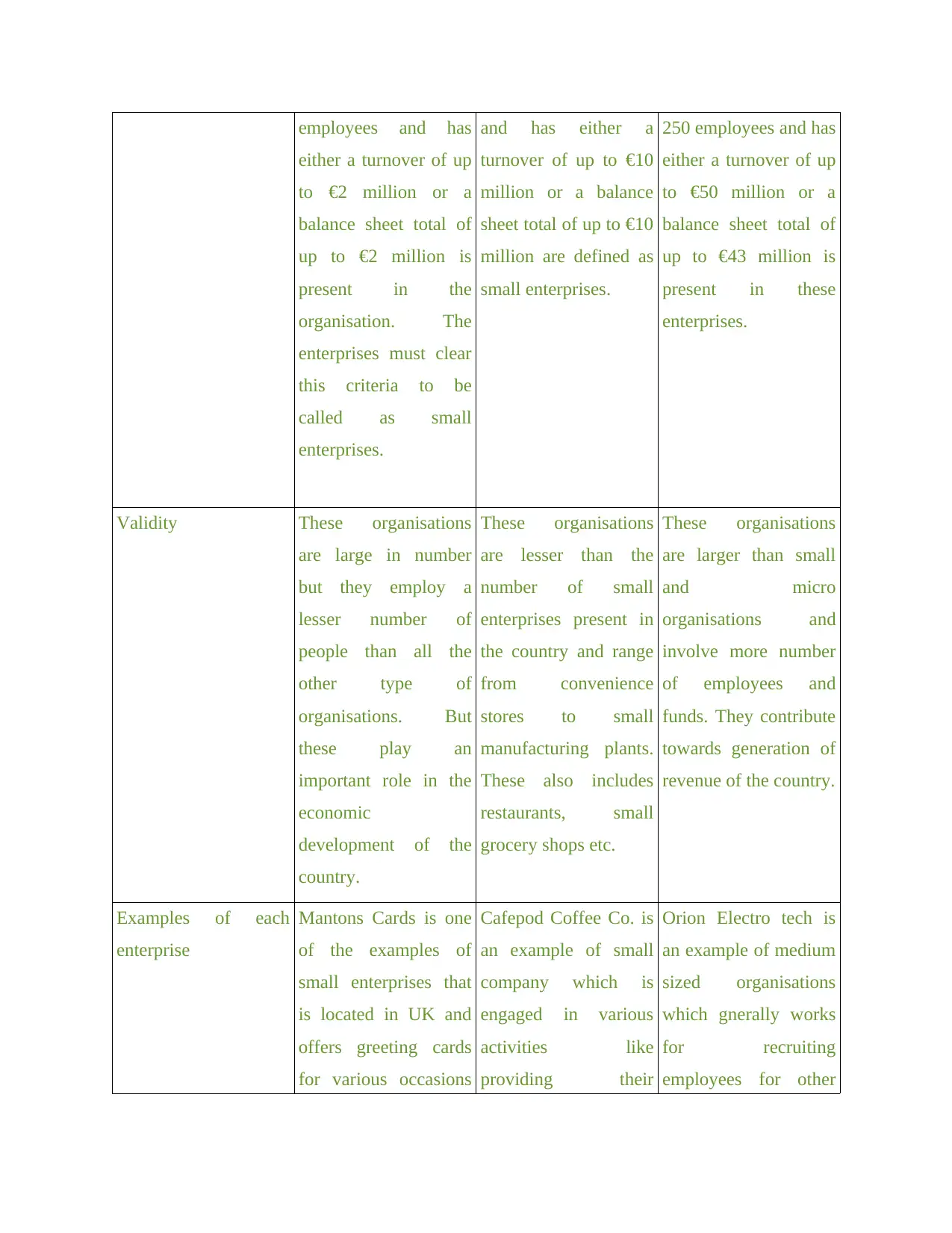
employees and has
either a turnover of up
to €2 million or a
balance sheet total of
up to €2 million is
present in the
organisation. The
enterprises must clear
this criteria to be
called as small
enterprises.
and has either a
turnover of up to €10
million or a balance
sheet total of up to €10
million are defined as
small enterprises.
250 employees and has
either a turnover of up
to €50 million or a
balance sheet total of
up to €43 million is
present in these
enterprises.
Validity These organisations
are large in number
but they employ a
lesser number of
people than all the
other type of
organisations. But
these play an
important role in the
economic
development of the
country.
These organisations
are lesser than the
number of small
enterprises present in
the country and range
from convenience
stores to small
manufacturing plants.
These also includes
restaurants, small
grocery shops etc.
These organisations
are larger than small
and micro
organisations and
involve more number
of employees and
funds. They contribute
towards generation of
revenue of the country.
Examples of each
enterprise
Mantons Cards is one
of the examples of
small enterprises that
is located in UK and
offers greeting cards
for various occasions
Cafepod Coffee Co. is
an example of small
company which is
engaged in various
activities like
providing their
Orion Electro tech is
an example of medium
sized organisations
which gnerally works
for recruiting
employees for other
either a turnover of up
to €2 million or a
balance sheet total of
up to €2 million is
present in the
organisation. The
enterprises must clear
this criteria to be
called as small
enterprises.
and has either a
turnover of up to €10
million or a balance
sheet total of up to €10
million are defined as
small enterprises.
250 employees and has
either a turnover of up
to €50 million or a
balance sheet total of
up to €43 million is
present in these
enterprises.
Validity These organisations
are large in number
but they employ a
lesser number of
people than all the
other type of
organisations. But
these play an
important role in the
economic
development of the
country.
These organisations
are lesser than the
number of small
enterprises present in
the country and range
from convenience
stores to small
manufacturing plants.
These also includes
restaurants, small
grocery shops etc.
These organisations
are larger than small
and micro
organisations and
involve more number
of employees and
funds. They contribute
towards generation of
revenue of the country.
Examples of each
enterprise
Mantons Cards is one
of the examples of
small enterprises that
is located in UK and
offers greeting cards
for various occasions
Cafepod Coffee Co. is
an example of small
company which is
engaged in various
activities like
providing their
Orion Electro tech is
an example of medium
sized organisations
which gnerally works
for recruiting
employees for other
Paraphrase This Document
Need a fresh take? Get an instant paraphrase of this document with our AI Paraphraser
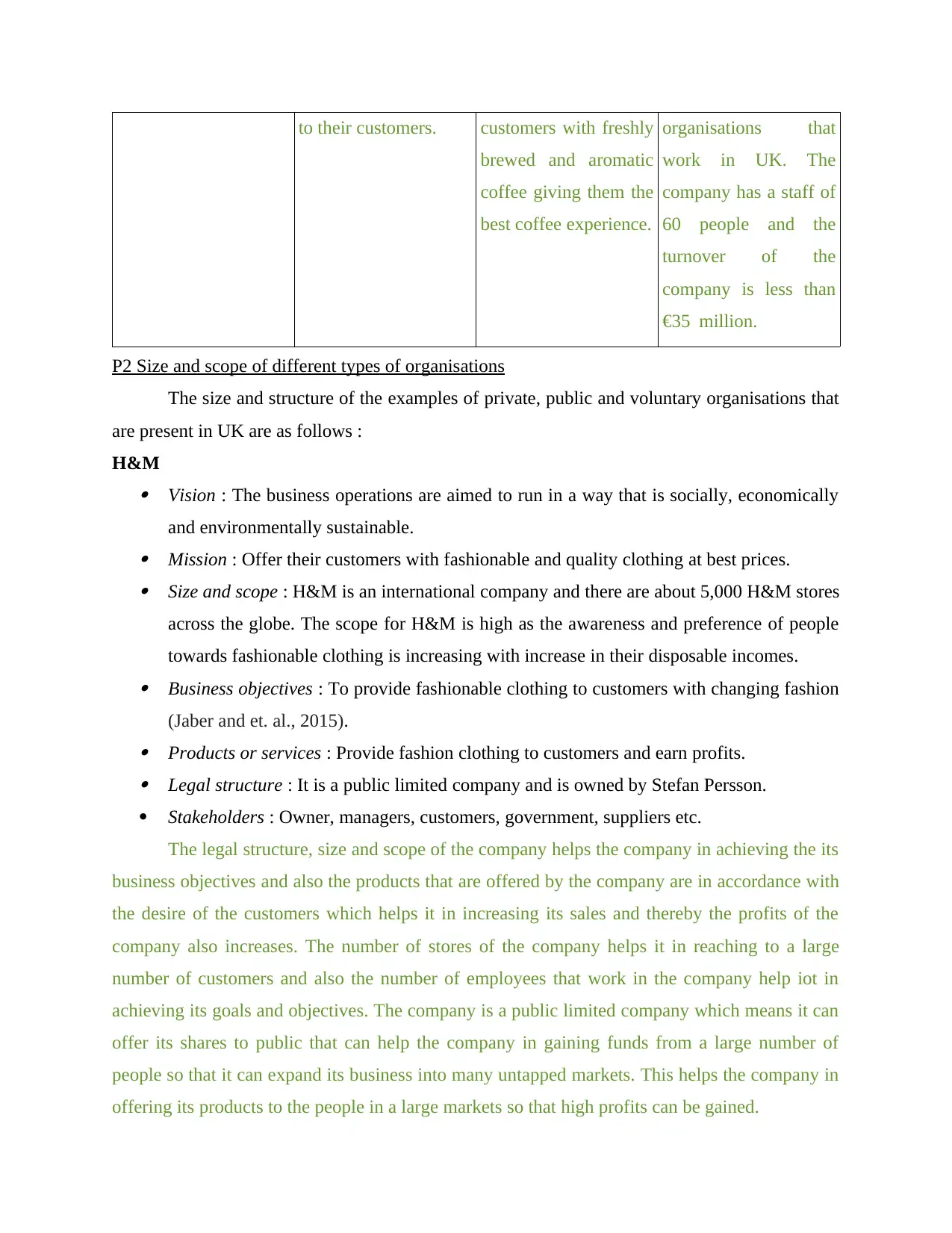
to their customers. customers with freshly
brewed and aromatic
coffee giving them the
best coffee experience.
organisations that
work in UK. The
company has a staff of
60 people and the
turnover of the
company is less than
€35 million.
P2 Size and scope of different types of organisations
The size and structure of the examples of private, public and voluntary organisations that
are present in UK are as follows :
H&M Vision : The business operations are aimed to run in a way that is socially, economically
and environmentally sustainable. Mission : Offer their customers with fashionable and quality clothing at best prices. Size and scope : H&M is an international company and there are about 5,000 H&M stores
across the globe. The scope for H&M is high as the awareness and preference of people
towards fashionable clothing is increasing with increase in their disposable incomes. Business objectives : To provide fashionable clothing to customers with changing fashion
(Jaber and et. al., 2015). Products or services : Provide fashion clothing to customers and earn profits. Legal structure : It is a public limited company and is owned by Stefan Persson.
Stakeholders : Owner, managers, customers, government, suppliers etc.
The legal structure, size and scope of the company helps the company in achieving the its
business objectives and also the products that are offered by the company are in accordance with
the desire of the customers which helps it in increasing its sales and thereby the profits of the
company also increases. The number of stores of the company helps it in reaching to a large
number of customers and also the number of employees that work in the company help iot in
achieving its goals and objectives. The company is a public limited company which means it can
offer its shares to public that can help the company in gaining funds from a large number of
people so that it can expand its business into many untapped markets. This helps the company in
offering its products to the people in a large markets so that high profits can be gained.
brewed and aromatic
coffee giving them the
best coffee experience.
organisations that
work in UK. The
company has a staff of
60 people and the
turnover of the
company is less than
€35 million.
P2 Size and scope of different types of organisations
The size and structure of the examples of private, public and voluntary organisations that
are present in UK are as follows :
H&M Vision : The business operations are aimed to run in a way that is socially, economically
and environmentally sustainable. Mission : Offer their customers with fashionable and quality clothing at best prices. Size and scope : H&M is an international company and there are about 5,000 H&M stores
across the globe. The scope for H&M is high as the awareness and preference of people
towards fashionable clothing is increasing with increase in their disposable incomes. Business objectives : To provide fashionable clothing to customers with changing fashion
(Jaber and et. al., 2015). Products or services : Provide fashion clothing to customers and earn profits. Legal structure : It is a public limited company and is owned by Stefan Persson.
Stakeholders : Owner, managers, customers, government, suppliers etc.
The legal structure, size and scope of the company helps the company in achieving the its
business objectives and also the products that are offered by the company are in accordance with
the desire of the customers which helps it in increasing its sales and thereby the profits of the
company also increases. The number of stores of the company helps it in reaching to a large
number of customers and also the number of employees that work in the company help iot in
achieving its goals and objectives. The company is a public limited company which means it can
offer its shares to public that can help the company in gaining funds from a large number of
people so that it can expand its business into many untapped markets. This helps the company in
offering its products to the people in a large markets so that high profits can be gained.
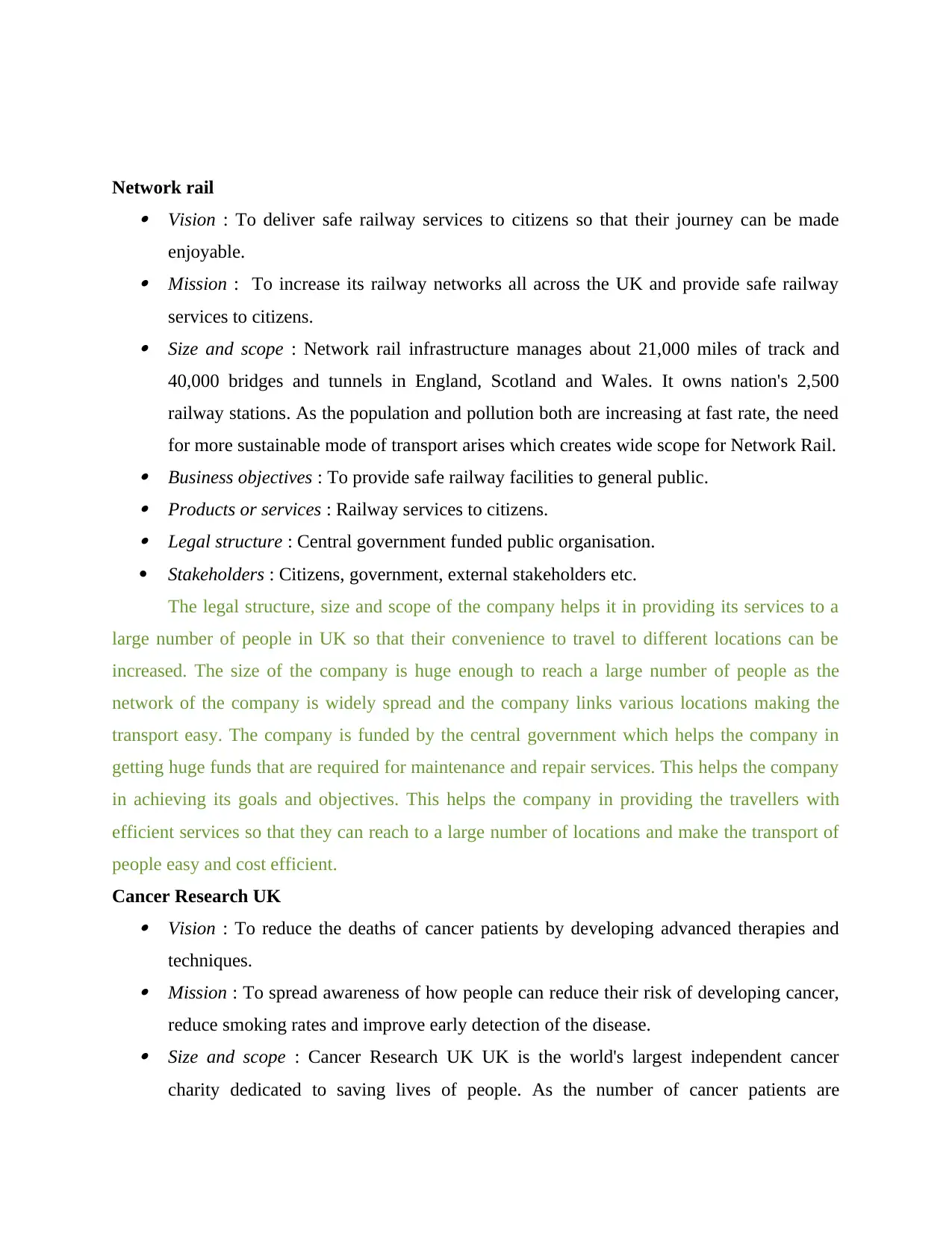
Network rail Vision : To deliver safe railway services to citizens so that their journey can be made
enjoyable. Mission : To increase its railway networks all across the UK and provide safe railway
services to citizens. Size and scope : Network rail infrastructure manages about 21,000 miles of track and
40,000 bridges and tunnels in England, Scotland and Wales. It owns nation's 2,500
railway stations. As the population and pollution both are increasing at fast rate, the need
for more sustainable mode of transport arises which creates wide scope for Network Rail. Business objectives : To provide safe railway facilities to general public. Products or services : Railway services to citizens. Legal structure : Central government funded public organisation.
Stakeholders : Citizens, government, external stakeholders etc.
The legal structure, size and scope of the company helps it in providing its services to a
large number of people in UK so that their convenience to travel to different locations can be
increased. The size of the company is huge enough to reach a large number of people as the
network of the company is widely spread and the company links various locations making the
transport easy. The company is funded by the central government which helps the company in
getting huge funds that are required for maintenance and repair services. This helps the company
in achieving its goals and objectives. This helps the company in providing the travellers with
efficient services so that they can reach to a large number of locations and make the transport of
people easy and cost efficient.
Cancer Research UK Vision : To reduce the deaths of cancer patients by developing advanced therapies and
techniques. Mission : To spread awareness of how people can reduce their risk of developing cancer,
reduce smoking rates and improve early detection of the disease. Size and scope : Cancer Research UK UK is the world's largest independent cancer
charity dedicated to saving lives of people. As the number of cancer patients are
enjoyable. Mission : To increase its railway networks all across the UK and provide safe railway
services to citizens. Size and scope : Network rail infrastructure manages about 21,000 miles of track and
40,000 bridges and tunnels in England, Scotland and Wales. It owns nation's 2,500
railway stations. As the population and pollution both are increasing at fast rate, the need
for more sustainable mode of transport arises which creates wide scope for Network Rail. Business objectives : To provide safe railway facilities to general public. Products or services : Railway services to citizens. Legal structure : Central government funded public organisation.
Stakeholders : Citizens, government, external stakeholders etc.
The legal structure, size and scope of the company helps it in providing its services to a
large number of people in UK so that their convenience to travel to different locations can be
increased. The size of the company is huge enough to reach a large number of people as the
network of the company is widely spread and the company links various locations making the
transport easy. The company is funded by the central government which helps the company in
getting huge funds that are required for maintenance and repair services. This helps the company
in achieving its goals and objectives. This helps the company in providing the travellers with
efficient services so that they can reach to a large number of locations and make the transport of
people easy and cost efficient.
Cancer Research UK Vision : To reduce the deaths of cancer patients by developing advanced therapies and
techniques. Mission : To spread awareness of how people can reduce their risk of developing cancer,
reduce smoking rates and improve early detection of the disease. Size and scope : Cancer Research UK UK is the world's largest independent cancer
charity dedicated to saving lives of people. As the number of cancer patients are
⊘ This is a preview!⊘
Do you want full access?
Subscribe today to unlock all pages.

Trusted by 1+ million students worldwide
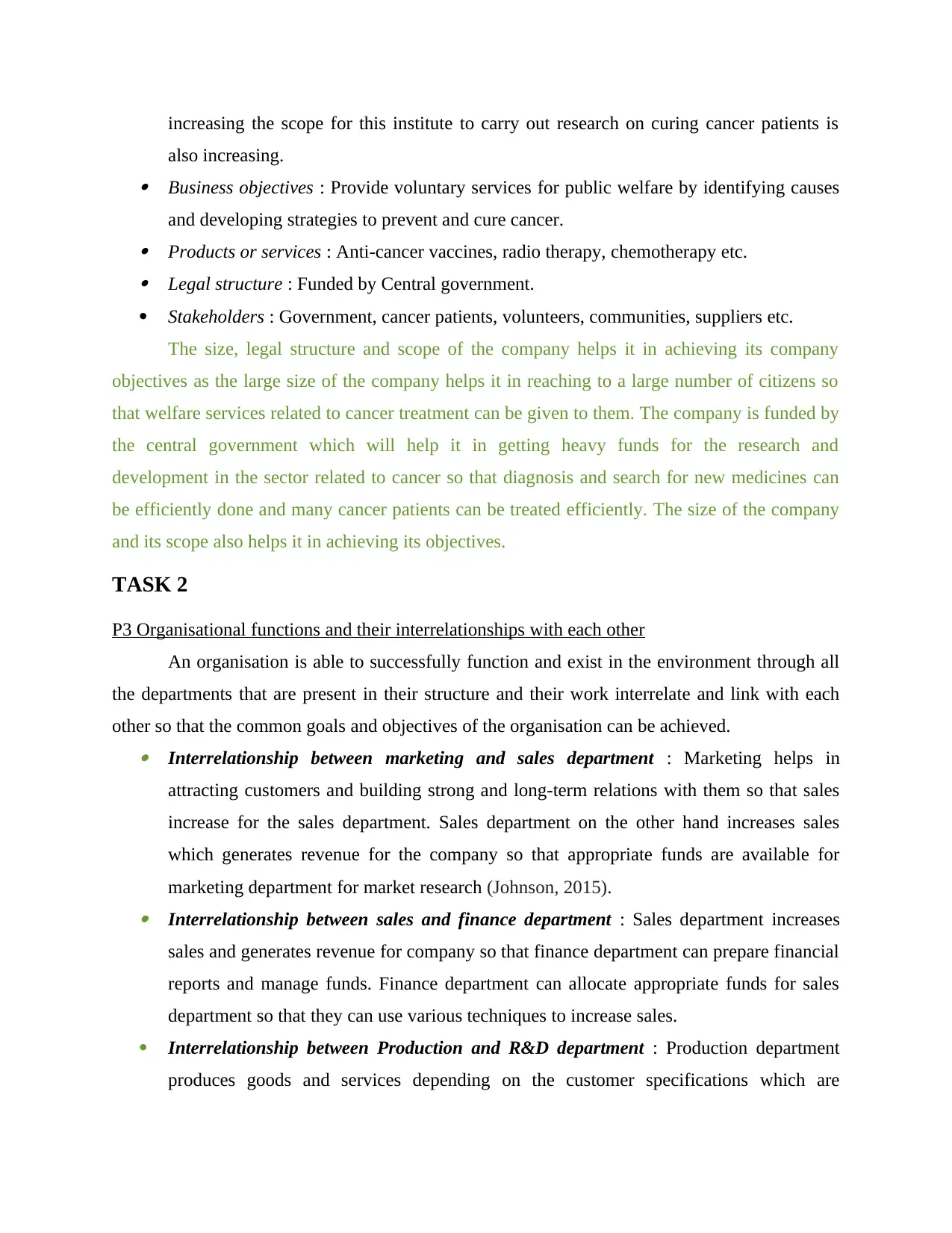
increasing the scope for this institute to carry out research on curing cancer patients is
also increasing. Business objectives : Provide voluntary services for public welfare by identifying causes
and developing strategies to prevent and cure cancer. Products or services : Anti-cancer vaccines, radio therapy, chemotherapy etc. Legal structure : Funded by Central government.
Stakeholders : Government, cancer patients, volunteers, communities, suppliers etc.
The size, legal structure and scope of the company helps it in achieving its company
objectives as the large size of the company helps it in reaching to a large number of citizens so
that welfare services related to cancer treatment can be given to them. The company is funded by
the central government which will help it in getting heavy funds for the research and
development in the sector related to cancer so that diagnosis and search for new medicines can
be efficiently done and many cancer patients can be treated efficiently. The size of the company
and its scope also helps it in achieving its objectives.
TASK 2
P3 Organisational functions and their interrelationships with each other
An organisation is able to successfully function and exist in the environment through all
the departments that are present in their structure and their work interrelate and link with each
other so that the common goals and objectives of the organisation can be achieved. Interrelationship between marketing and sales department : Marketing helps in
attracting customers and building strong and long-term relations with them so that sales
increase for the sales department. Sales department on the other hand increases sales
which generates revenue for the company so that appropriate funds are available for
marketing department for market research (Johnson, 2015). Interrelationship between sales and finance department : Sales department increases
sales and generates revenue for company so that finance department can prepare financial
reports and manage funds. Finance department can allocate appropriate funds for sales
department so that they can use various techniques to increase sales.
Interrelationship between Production and R&D department : Production department
produces goods and services depending on the customer specifications which are
also increasing. Business objectives : Provide voluntary services for public welfare by identifying causes
and developing strategies to prevent and cure cancer. Products or services : Anti-cancer vaccines, radio therapy, chemotherapy etc. Legal structure : Funded by Central government.
Stakeholders : Government, cancer patients, volunteers, communities, suppliers etc.
The size, legal structure and scope of the company helps it in achieving its company
objectives as the large size of the company helps it in reaching to a large number of citizens so
that welfare services related to cancer treatment can be given to them. The company is funded by
the central government which will help it in getting heavy funds for the research and
development in the sector related to cancer so that diagnosis and search for new medicines can
be efficiently done and many cancer patients can be treated efficiently. The size of the company
and its scope also helps it in achieving its objectives.
TASK 2
P3 Organisational functions and their interrelationships with each other
An organisation is able to successfully function and exist in the environment through all
the departments that are present in their structure and their work interrelate and link with each
other so that the common goals and objectives of the organisation can be achieved. Interrelationship between marketing and sales department : Marketing helps in
attracting customers and building strong and long-term relations with them so that sales
increase for the sales department. Sales department on the other hand increases sales
which generates revenue for the company so that appropriate funds are available for
marketing department for market research (Johnson, 2015). Interrelationship between sales and finance department : Sales department increases
sales and generates revenue for company so that finance department can prepare financial
reports and manage funds. Finance department can allocate appropriate funds for sales
department so that they can use various techniques to increase sales.
Interrelationship between Production and R&D department : Production department
produces goods and services depending on the customer specifications which are
Paraphrase This Document
Need a fresh take? Get an instant paraphrase of this document with our AI Paraphraser
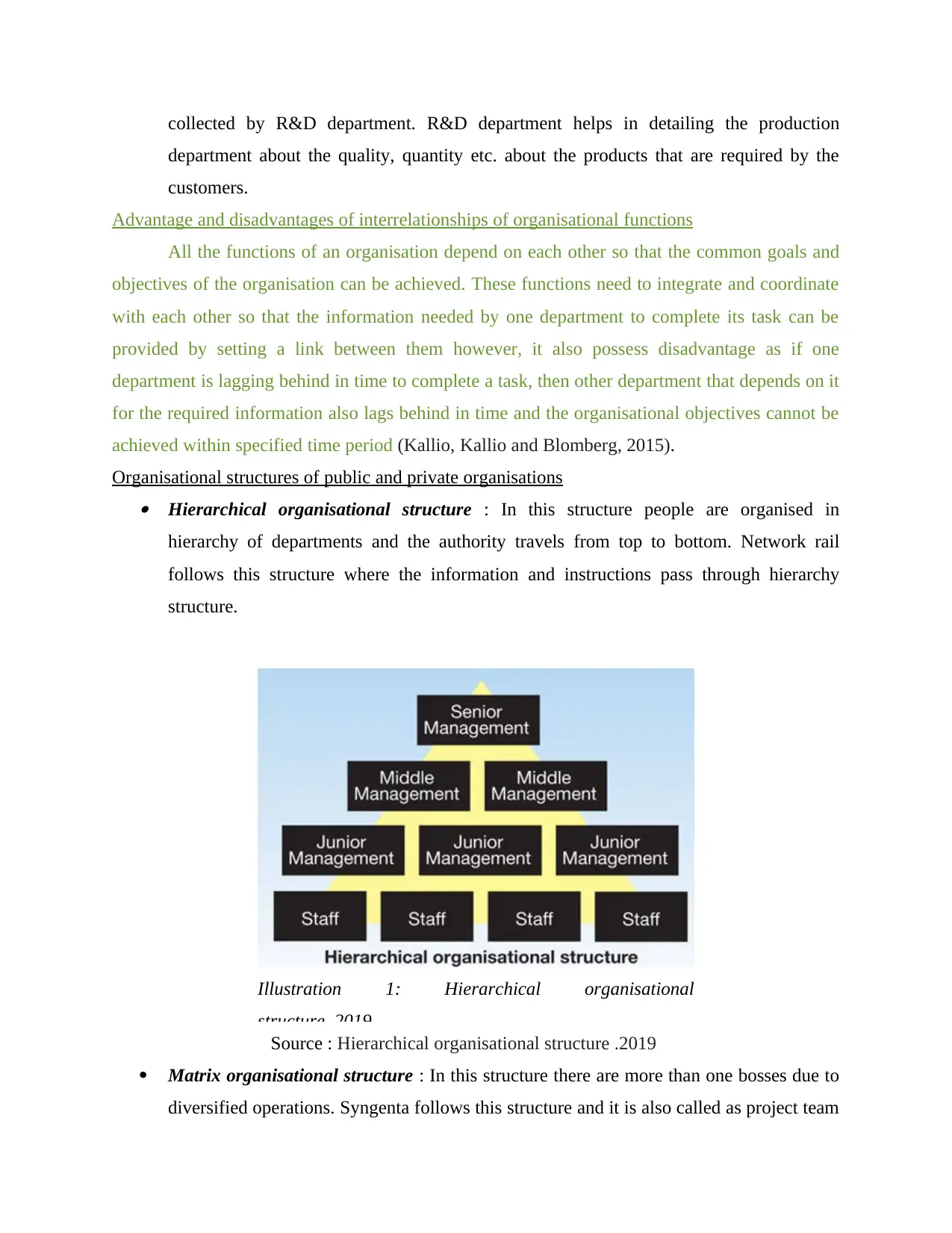
collected by R&D department. R&D department helps in detailing the production
department about the quality, quantity etc. about the products that are required by the
customers.
Advantage and disadvantages of interrelationships of organisational functions
All the functions of an organisation depend on each other so that the common goals and
objectives of the organisation can be achieved. These functions need to integrate and coordinate
with each other so that the information needed by one department to complete its task can be
provided by setting a link between them however, it also possess disadvantage as if one
department is lagging behind in time to complete a task, then other department that depends on it
for the required information also lags behind in time and the organisational objectives cannot be
achieved within specified time period (Kallio, Kallio and Blomberg, 2015).
Organisational structures of public and private organisations Hierarchical organisational structure : In this structure people are organised in
hierarchy of departments and the authority travels from top to bottom. Network rail
follows this structure where the information and instructions pass through hierarchy
structure.
Source : Hierarchical organisational structure .2019
Matrix organisational structure : In this structure there are more than one bosses due to
diversified operations. Syngenta follows this structure and it is also called as project team
Illustration 1: Hierarchical organisational
structure .2019
department about the quality, quantity etc. about the products that are required by the
customers.
Advantage and disadvantages of interrelationships of organisational functions
All the functions of an organisation depend on each other so that the common goals and
objectives of the organisation can be achieved. These functions need to integrate and coordinate
with each other so that the information needed by one department to complete its task can be
provided by setting a link between them however, it also possess disadvantage as if one
department is lagging behind in time to complete a task, then other department that depends on it
for the required information also lags behind in time and the organisational objectives cannot be
achieved within specified time period (Kallio, Kallio and Blomberg, 2015).
Organisational structures of public and private organisations Hierarchical organisational structure : In this structure people are organised in
hierarchy of departments and the authority travels from top to bottom. Network rail
follows this structure where the information and instructions pass through hierarchy
structure.
Source : Hierarchical organisational structure .2019
Matrix organisational structure : In this structure there are more than one bosses due to
diversified operations. Syngenta follows this structure and it is also called as project team
Illustration 1: Hierarchical organisational
structure .2019
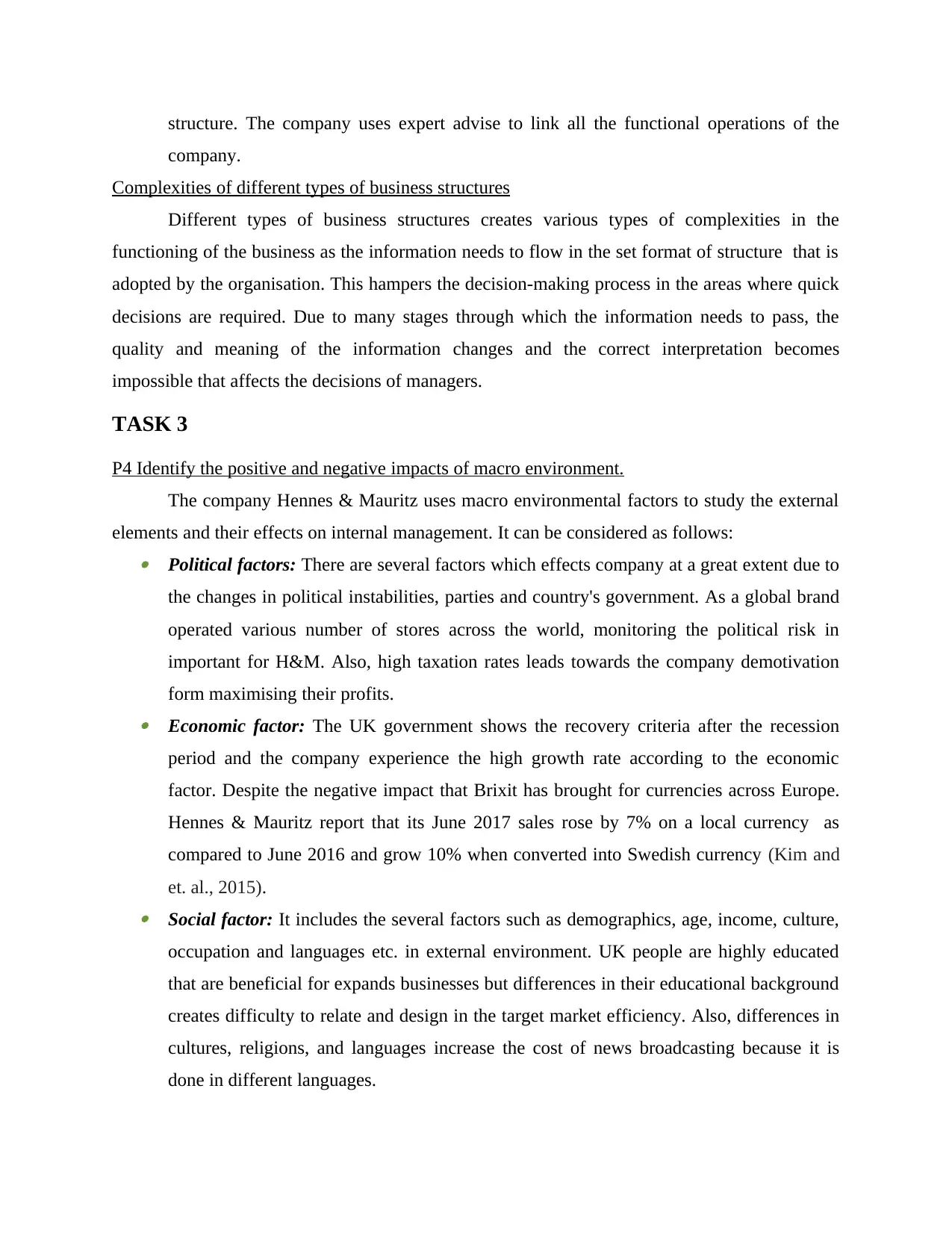
structure. The company uses expert advise to link all the functional operations of the
company.
Complexities of different types of business structures
Different types of business structures creates various types of complexities in the
functioning of the business as the information needs to flow in the set format of structure that is
adopted by the organisation. This hampers the decision-making process in the areas where quick
decisions are required. Due to many stages through which the information needs to pass, the
quality and meaning of the information changes and the correct interpretation becomes
impossible that affects the decisions of managers.
TASK 3
P4 Identify the positive and negative impacts of macro environment.
The company Hennes & Mauritz uses macro environmental factors to study the external
elements and their effects on internal management. It can be considered as follows: Political factors: There are several factors which effects company at a great extent due to
the changes in political instabilities, parties and country's government. As a global brand
operated various number of stores across the world, monitoring the political risk in
important for H&M. Also, high taxation rates leads towards the company demotivation
form maximising their profits. Economic factor: The UK government shows the recovery criteria after the recession
period and the company experience the high growth rate according to the economic
factor. Despite the negative impact that Brixit has brought for currencies across Europe.
Hennes & Mauritz report that its June 2017 sales rose by 7% on a local currency as
compared to June 2016 and grow 10% when converted into Swedish currency (Kim and
et. al., 2015). Social factor: It includes the several factors such as demographics, age, income, culture,
occupation and languages etc. in external environment. UK people are highly educated
that are beneficial for expands businesses but differences in their educational background
creates difficulty to relate and design in the target market efficiency. Also, differences in
cultures, religions, and languages increase the cost of news broadcasting because it is
done in different languages.
company.
Complexities of different types of business structures
Different types of business structures creates various types of complexities in the
functioning of the business as the information needs to flow in the set format of structure that is
adopted by the organisation. This hampers the decision-making process in the areas where quick
decisions are required. Due to many stages through which the information needs to pass, the
quality and meaning of the information changes and the correct interpretation becomes
impossible that affects the decisions of managers.
TASK 3
P4 Identify the positive and negative impacts of macro environment.
The company Hennes & Mauritz uses macro environmental factors to study the external
elements and their effects on internal management. It can be considered as follows: Political factors: There are several factors which effects company at a great extent due to
the changes in political instabilities, parties and country's government. As a global brand
operated various number of stores across the world, monitoring the political risk in
important for H&M. Also, high taxation rates leads towards the company demotivation
form maximising their profits. Economic factor: The UK government shows the recovery criteria after the recession
period and the company experience the high growth rate according to the economic
factor. Despite the negative impact that Brixit has brought for currencies across Europe.
Hennes & Mauritz report that its June 2017 sales rose by 7% on a local currency as
compared to June 2016 and grow 10% when converted into Swedish currency (Kim and
et. al., 2015). Social factor: It includes the several factors such as demographics, age, income, culture,
occupation and languages etc. in external environment. UK people are highly educated
that are beneficial for expands businesses but differences in their educational background
creates difficulty to relate and design in the target market efficiency. Also, differences in
cultures, religions, and languages increase the cost of news broadcasting because it is
done in different languages.
⊘ This is a preview!⊘
Do you want full access?
Subscribe today to unlock all pages.

Trusted by 1+ million students worldwide
1 out of 21
Related Documents
Your All-in-One AI-Powered Toolkit for Academic Success.
+13062052269
info@desklib.com
Available 24*7 on WhatsApp / Email
![[object Object]](/_next/static/media/star-bottom.7253800d.svg)
Unlock your academic potential
Copyright © 2020–2025 A2Z Services. All Rights Reserved. Developed and managed by ZUCOL.





